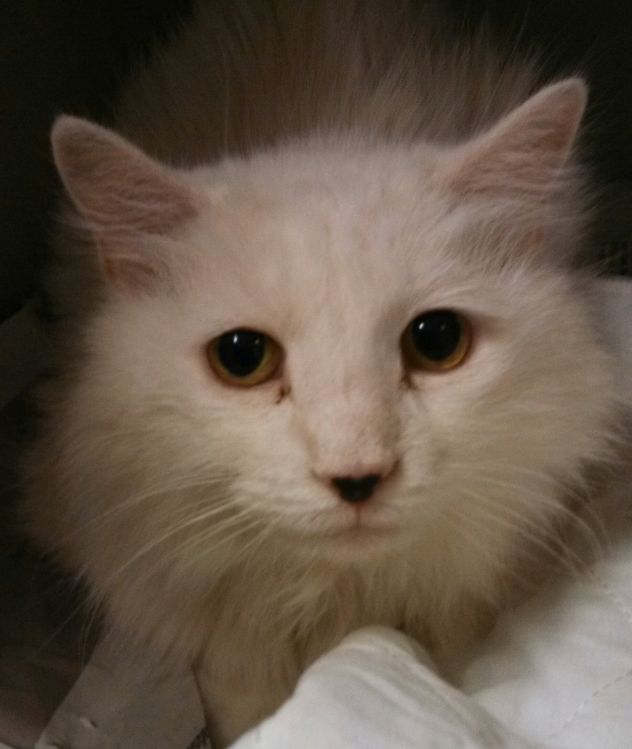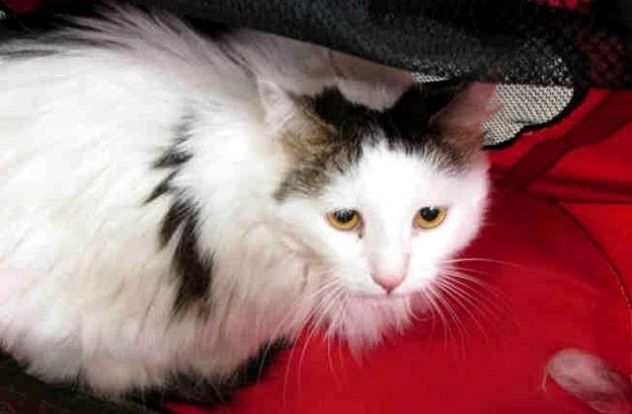http://www.mochasmysteriesmeows.com/2017/01/book-review-cat-sitter-and-canary-by.html
Tickle, the peaches-and-cream-colored son of Tortie Queen Heather, was the one who did something cute last night. He was lonesome. His mother went off hunting, his human went off to work, and although a normal cat's reaction would have been "Yesss! I am monarch of all I survey!" Tickle is a social cat. When I came in he nonverbally said "Finally!" and immediately started clawing at the wheelbarrow. This could have been a normal cat's dominance display, and probably started out as a reaction to the same impulse; the cute part was that when I said, "Stop that, or I'll trim your claws," Tickle immediately ran to the door, purring and nonverbally saying "Yes please."
Trimming Tickle's claws is a bit of a trick because he has a weak form of the polydactyl gene--just one half of an extra "thumb" toe on one paw, in between the toes corresponding to the thumb and index finger, where the extra claw is hard to reach. The half-toe has to be pinched to extend the claw while the clippers are angled in between the normal toes. It's obviously a ticklish job, and he always acts as if he'd hoped I'd forget that claw.
However, he purrs and cuddles while being clipped. I asked him whether he was trying to suggest a cat blog post. Frankly I don't think he understands any words at all. All tame cats recognize the general tones of "calling" and "scolding," so they react to anything in the same category as "Here, Kitty" and "Stop that," and with Tickle that's as far as it seems to go. Nevertheless, his nonverbal reply to the question was definitely a "yes." If it was more of a "Yes, hold me and groom me" than a "Yes, readers need to know that cats like a good manicure," well, he's a nice cat as adolescent tomcats go; most cats are not Listening Pets.
Anyway, you the human may want to discourage your cats clawing at doors, things stored outside, even things stored inside if you let them hang out indoors, and there is a humane way to accomplish that.
Cats run their paws and claws over things to leave subtle scent messages that other cats and dogs recognize. They flex their claws while kneading a friend's skin; they naturally use the right amount of pressure that this caress apparently feels good to other cats, which means it takes a little time to train them not to sink their claws into human skin and clothing, which are more vulnerable. They also use their claws as weapons if they ever get into a serious fight or want to destroy an object, which we can hope they never will. Those behaviors will not go away, nor, in most cases, will they do you or your pet any harm.
But the most common reason why cats claw at wood or upholstery, extensively, leaving upholstery hanging in shreds if they have a chance, is simply to wear down the long sharp ends of their claws...and once they learn to trust that a human is not going to hurt them but to give them a nice manicure, they'll tell that human when it's time for the next trimming. Cats don't have a natural instinct to let other lifeforms take care of their claws, but they can learn quickly. Between the benefits of (1) being scolded for trimming your own nails in the way that naturally occurs to you, and (2) being petted, praised, and rewarded for letting someone else trim your nails, which would you prefer to do?
Cat Sanctuary cats have a choice. They can take full responsibility for filing their own claws to the length and shape they prefer, on pieces of dead wood I'll leave in the yard if a cat is using them; or they can let me know that they want the manicure job, which includes praise and petting and, if they cooperate, a treat. I prefer that they take care of their own claws, actually. Magic, our Founding Queen, always did. Heather, our Reigning Queen, usually does. Sometimes a clingy junior cat will solicit another manicure in the same week, if it's been a stressful week--just for the attention. Most of the cats, like Tickle, take care of their own claws for weeks on end but enlist human help when they feel lonely, bored, or stressed.
If you want to keep a cat indoors permanently, which tends to induce neurotic behavior, you should begin by providing a few things you can encourage the cat to scratch--wood, carpeting material, maybe other surfaces if your cat wants to scratch them. Then, if the cat scratches other things, take a toenail clipper and snip off only the white ends of dead tissue from its claws. (The pink inner core that's visible at the base of each claw is sensitive flesh. Don't touch it. If you clip down into the quick the toe will bleed profusely and the cat will walk with a limp for a few days.) Clipping a cat's claws should be as much fun for the cat as getting a manicure is for...the kind of human who loves hanging out on the mall.
There is no excuse for the surgical operation known as "declawing," which is like removing all of a human's fingertips. Declawing is now illegal in many places, and even when no specific local law bans it, many vets now refuse to do the operation.
There are, however, some cats who have been declawed, who need homes. Fair disclosure: these cats will be living the rest of their lives with pain, so they may behave oddly. I once lived with a declawed cat who demonstrated a range of coping behaviors that dramatized how cruel the operation is--soaking her paws in cold water for hours, biting at her paws, lying on her back with her paws up, running madly up and down the stairs apparently for a sort of counter-irritant effect, and of course using the bathtub to force humans to remove bodywastes rather than scooping litter over a puddle or pile with her poor sore paws. If you're up for a real humanitarian challenge, however, you might try rehabilitating a survivor of declawing. They can still be lovable pets, especially if they're either never allowed in the bathroom, or else trained to use the toilet like human children (some long-legged cats can learn this trick). They must, of course, be kept indoors.
I thought a nice way to end this thought might be to spotlight declawed cats at Petfinder.com. Well, hurrah! Half a dozen searches failed to turn up one! Here, however, are some cats that do have special needs. I don't really believe cats mind having kittens, so I distrust humans who post about how a cat's horrid, mean former owners "didn't care that I got pregnant." (So, the cat was expelled from college? Passed over for a promotion? Really.) That's the Humane (Pet Genocide) Society, which has unfortunately fallen into the hands of people who really want domestic animals to go extinct, putting their words in the cat's mouth. But I'll agree that long-haired, pale-colored cats really need to do most--if not all--of their continual shedding in a nice cool cellar on a nice pale-colored rug. These "glamourpusses" don't seem to enjoy the caresses humans always rush to offer them; in my part of the world they usually look as if they're burning up in those coats. They are undeniably beautiful, in winter...and if you can bear to spoil their looks and trim the fur, long-haired cats may become as cuddly as short-haired ones.
 |
| Penelope from Brooklyn...like most long-haired cats, needs occasional dietary supplements to keep from choking on her own fur: https://www.petfinder.com/petdetail/27828123 |
 |
| Serenity from Fayetteville is a prisoner in a Humane Society shelter. Is it more important to rescue her, or to withhold support/funding from HSUS shelters? Your call. If you want to rescue her: https://www.petfinder.com/petdetail/37152218 |
 |
| Annabella from upper Montgomery County, Maryland, is another prisoner of HSUS "rescuers" who at least use the page they've set up for her to reiterate the point of this post about minimizing furniture shredding. Her eyes will always have that shape, but they may just possibly stop rolling upward in that expressive way when she stops hearing HSUS propaganda about the alleged cat overpopulation problem: https://www.petfinder.com/petdetail/35506986 |
Isolated social cats, however, seem to like living with normal cats as their pets. Adults bond as friends even if they don't try to mate, and adopt kittens...that's how vets and shelter staff are able to recognize social cats. A minority of cats are truly antisocial (and last fall we met one of those) but the majority are simply non-social, and can be socialized by social cats.
No comments:
Post a Comment